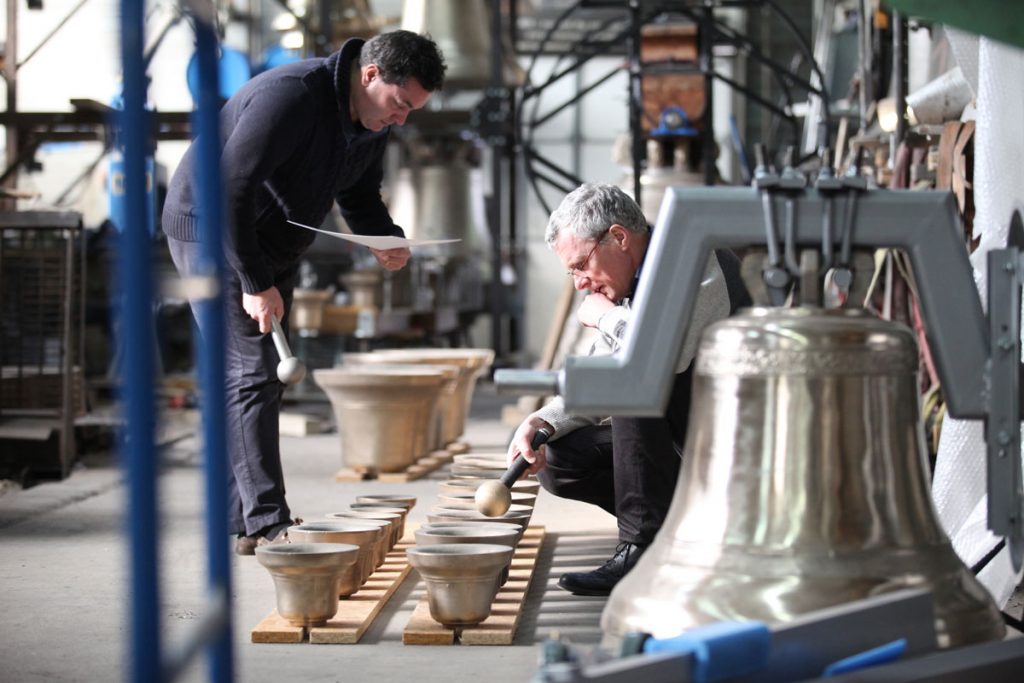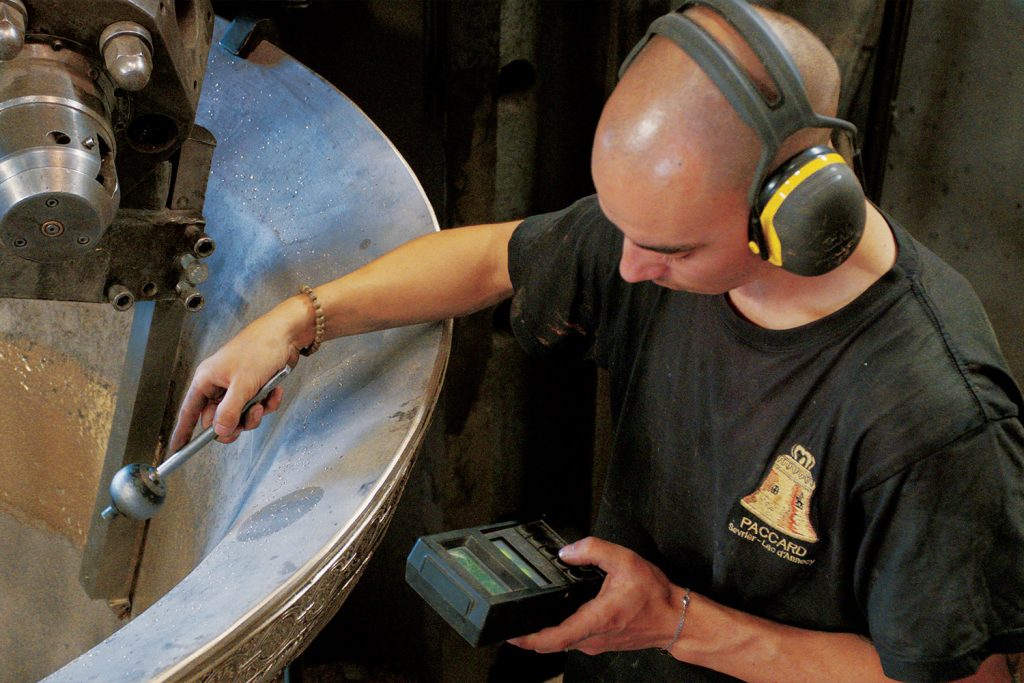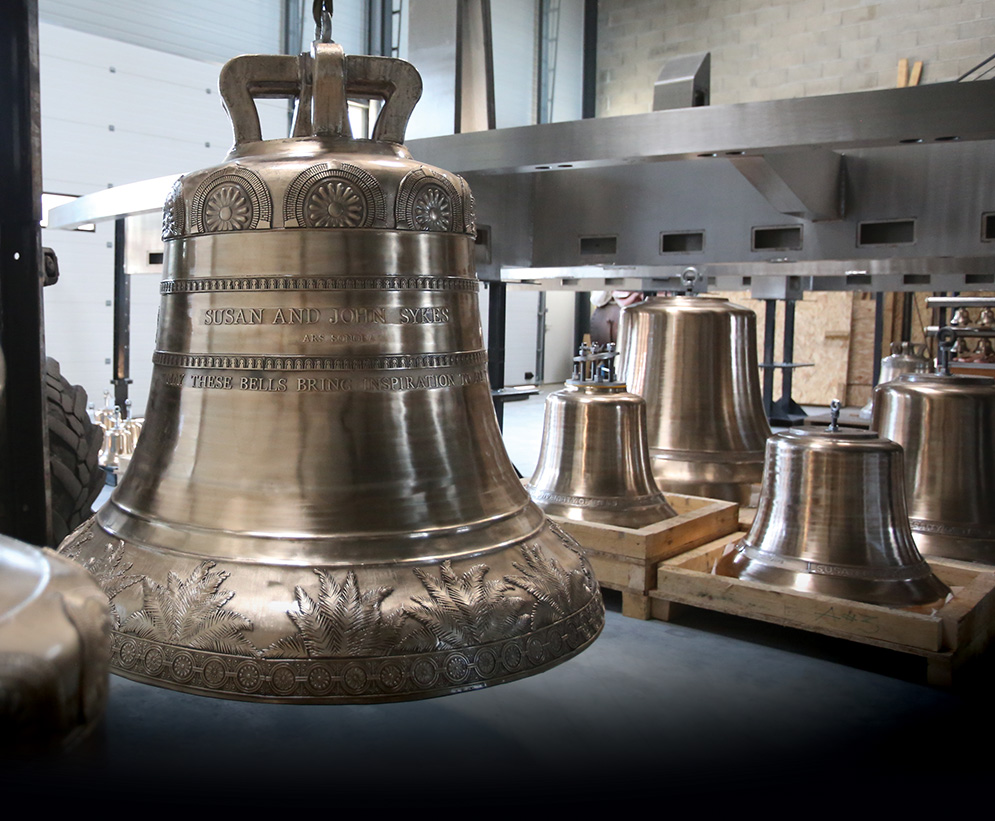
Bell tuners
harmonic perfection

Paccard bells, as a result of their unique profile, exacting bronze metal mixture and tuning
perfection, have earned the PACCARD Bell Foundry its worldwide reputation. Like Steinway,
Fazoli, Delmer, or Stradivarius, PACCARD is synonymous with musical excellence.
A bell is a genuine musical instrument that produces a rich, vibrant sound. The strike of the bell clapper awakens a bouquet of notes within the bronze. When set into resonance, it generates a fundamental (primary) sound along with harmonics (secondary sounds).
The intensity and variety of these harmonics contribute to the unique tone of each instrument. PACCARD’s artisanal tuning method creates the exacting musical quality for which PACCARD bells are known. A tuner precisely adjusts each bell’s harmonics by etching the interior of the bell, reducing its thickness ever so slightly to achieve the exact key-specific musical note. The process requires both precision, patience and expertise. PACCARD’s master tuners must continuously pause during the etching process to test the bell’s harmonics, using high-end contemporary digital as well as tuning forks and their discerning ears to achieve the desired result. PACCARD’s bell tuners are members of a select few bell makers worldwide who have mastered this precise tuning technique.


From its inception, a bell produces a specific note that is determined by its size and shape. Larger bells generate deeper notes, while smaller bells produce higher notes. The largest bells, known as bourdon bells, have the deepest tones. When a bell is struck, it does not emit a single note; instead, it creates a melody comprised of harmonious and melodious chords, specifically a minor arpeggio. This arpeggio consists of the octave below, along with additional tones: the fundamental note, the minor third, the fifth, and the upper octave.
A properly tuned bell remains in tune indefinitely. That is why the philosopher Alain described the bell as the perfect musical instrument.
The bell is the perfect musical instrument.
History
Know-how
Misson & Value
Mastery of the shape, quality of the metal and precision of the tuning have given PACCARD Foundry its worldwide reputation. Like Stainway, Fazoli, Delmer or Stradivarius, PACCARD is today synonymous with musical excellence. The bell, an instrument with a very rich sound does not, however, naturally give a fundamental note accompanied by right and judiciously dosed harmonics. The strike of the clapper awakens a whole variety of sounds within the bronze : a real bouquet of notes. It is the tuning of the notes that will bring out the power and purity of the fundamental. It is their intensity that creates the richness and the breadth of the tone.
The bell is a real musical instrument. When set in resonance, it produces a main sound – called Fundamental – and secondary sounds called Harmonics – Octave Below, Minor Third, Fifth and Upper Octave – which are perfectly measurable.
The intensity and the the variety of these different harmonics constitute the tone, particular to each instrument. However the bell has a distinctive feature : its third harmonic is slightly diminished, making it a minor third. This is what gives the bell its particular, a little melancholic tone.
Particular care is taken in the tuning of each of our bells. This technique consists in slightly modifying the shape – by removing metal inside the bell – in order to perfectly adjust, one by one, the five harmonics that make up the tone. Each bell – and each harmonic- is tuned to the 1/100th of a semi-tone.
Although electronic devices are nowadays used to check the accuracy of the bell’s tone, at PACCARD Foundry, it is the ear alone that determines the whole operation. This not only tunes each individual bell, but also the bells of the same carillon in relation to each other.
In the whole world only a very small number of bell founders have mastered this tuning technique. They are called chime makers.




Since its formation in 1796, the PACCARD Bell Foundry has worked in the service of Christian Faith by making bells for churches and chapels around the world. Today, tradition and modernity are PACCARD’s keywords. Through combining time-proven methods with advanced technologies, the company has expanded the use of bells into secular contexts, bringing the joy and inspiration of bells to a wider audience.
Even as the technology we use evolves, our work ethic continues to be based on our original value system: the search for what is right and good; a love of beauty; a commitment to excellence in all we do; and respect of others.





